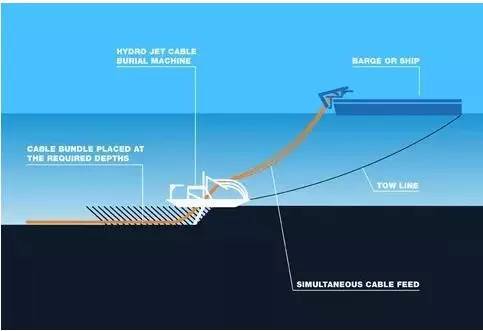The Internet is already an indispensable part of our lives, and the submarine
fiber optic cable is the "central nerve" of the Internet. It carries more than
90% of the world's international voice and data transmission. Without it, the
Internet is just a local area network. It is important to know that the total
length of submarine optical cables in the world is 900,000 kilometers, which can
circle the earth 22 times.
Submarine optical cables are the same as terrestrial optical cables, with a
core of the size of a hair wire in the middle, however, submarine optical cables
need more enhanced armor protection. From the outside to the inside, it is
divided into: polyethylene layer, polyester resin, stranded wire layer, aluminum
waterproof layer, carbonic acid resin layer, copper pipe, paraffin, alkane
layer, and finally to the optical fiber. Such multiple layers of protection are
to prevent the corrosion of seawater. The outer polymer layer is to prevent the
reaction of seawater and reinforced steel cables to produce hydrogen. Even if
the outer layer is really corroded, the inner copper tubes, paraffin, and
carbonic acid resin are also Prevents hydrogen from damaging the fiber. But no
matter how well the mechanism is designed, the fiber will still be damaged.
Generally speaking, the life of the cable is 25 years.
So how is the submarine optical cable laid in the deep sea?
One end of the optical cable is fixed on the shore, and the ship slowly moves
out to the sea. While sinking the optical cable or cable into the sea floor, it
is laid by an excavator sinking to the sea floor.

Two important pieces of equipment are mentioned here: the ship (optical cable
ship) and the subsea excavator.
1. The use of fiber-optic cable boats is required for the installation of
transoceanic cables. When laying, a large volume of optical cables should be
placed on the ship. At present, the most advanced optical cable laying ships can
carry 2,000 kilometers of optical cables and lay at a speed of 200 kilometers /
day.
2. The other part of the Subsea Optical Cable Laying ship is the subsea
excavator, which will initially be placed on shore and connected to the fixed
end of the optical cable. Its function is a bit like ploughing a field. For an
optical cable, it is a counterweight that sinks the optical cable into the ocean
floor. The excavator will be towed forward by the ship and will complete three
tasks. The first is to use high-pressure water to flush the sediment on the sea
floor and form optical cable trenches; the second is to lay optical cables
through the optical cable holes; the third is to bury the wires and cover the
sediment on both sides of the optical cable.
To put it simply, the cable laying ship is the cable laying, and the
excavator is really laying the cable. However, the transoceanic cable is
relatively thick and the flexibility is relatively poor, so the forward speed of
the ship must be strictly controlled.
In addition, on the rugged sea floor, robots are required to constantly
detect the best path to prevent the cables from being damaged by rocks.
Note: If you found anything violating your copyright, please contact us, we would remove them as soon as possible.




